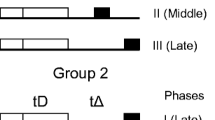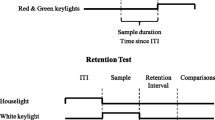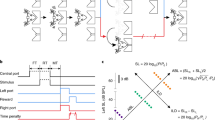Abstract
Pigeons were trained to respond on a multiple fixed-interval (FI) 60-sec/time-out 30-sec schedule with an added light whose intensity increased discretely every 10 sec during the 60-sec FI. During generalization testing in extinction, the light intensities were presented in pseudorandom order during the FI so that each light intensity appeared equally often during each 10-sec segment. A generalization surface was constructed for the 36 combinations of light intensity and 10-sec segment. The generalization surface showed that responding was a joint function of both light intensity and time since the beginning of the FI with light intensity exerting more control over responding than time since the beginning of the interval.
Similar content being viewed by others
References
BARON, M. R. 1965. The stimulus, stimulus control and stimulus generalization. In D. I. Mostofsky (Ed.), Stimulus generalization. Stanford: Stanford University Press.
CAPLAN, H. J., KARPICKE, J., & RILLING, M. 1973. Effects of extended fixed-interval training on reversed scallops. Animal Learning and Behavior, 1, 293–296.
CATANIA, A. C. 1970. Reinforcement schedules and psychophysical judgments: A study of some temporal properties of behavior. In W. M. Schoenfeld (Ed.), The theory of reinforcement schedules. New York: Appleton.
DONAHOE, J. W. 1970. Stimulus control within response sequences. In J. H. Reynierse (Ed.), Current issues in animal learning: A colloquium. Lincoln, Nebraska: University of Nebraska Press.
FERSTER, C. B., & SKINNER, B. F. 1957. Schedules of reinforcement. New York: Appleton-Century-Crofts.
JOHNSON, D. F. 1966. A device for rapid presentation of monochromatic stimuli, Journal of the Experimental Analysis of Behavior, 9, 335–336.
JOHNSON, D. F., & CUMMING, W. W. 1968. Some determiners of attention. Journal of the Experimental Analysis of Behavior, 2, 157–166.
NEWMAN, F. L., & BARON, M. R. 1965. Stimulus generalization along the dimension of angularity: A comparison of training procedures. Journal of Comparative and Physiological Psychology, 60, 59–63.
REYNOLDS, G. S. 1961. Attention in the pigeon. Journal of the Experimental Analysis of Behavior, 4, 203–208.
SCHNEIDER, B. A. 1969. A two-state analysis of fixed-interval responding in the pigeon. Journal of the Experimental Analysis of Behavior, 12, 677–687.
SKINNER, B. F. 1938. The behavior of organisms. New York: Appleton-Century-Crofts.
WILKIE, D. M., & MASSON, M. E. 1976. Attention in the pigeon: A reevaluation. Journal of the Experimental Analysis of Behavior, 26, 207–212.
Author information
Authors and Affiliations
Additional information
This research was supported by NSF Grant GB 36211. We would like to thank Harvey Cohen for his help with the experiment.
Rights and permissions
About this article
Cite this article
Schneider, B., Goodkin, F. & Olsen, K. Multidimensional Control of Fixed-Interval Responding by Light Intensity and Time. Psychol Rec 30, 123–130 (1980). https://doi.org/10.1007/BF03394660
Published:
Issue Date:
DOI: https://doi.org/10.1007/BF03394660




